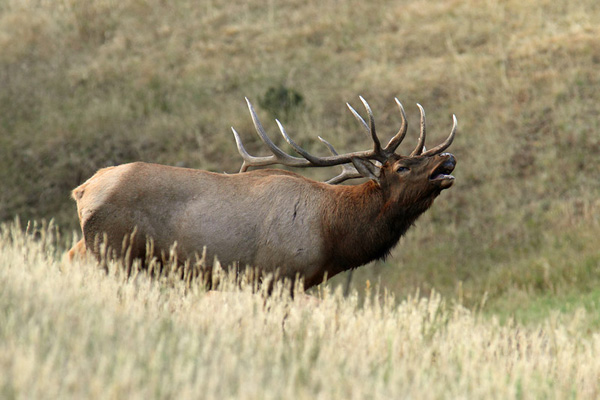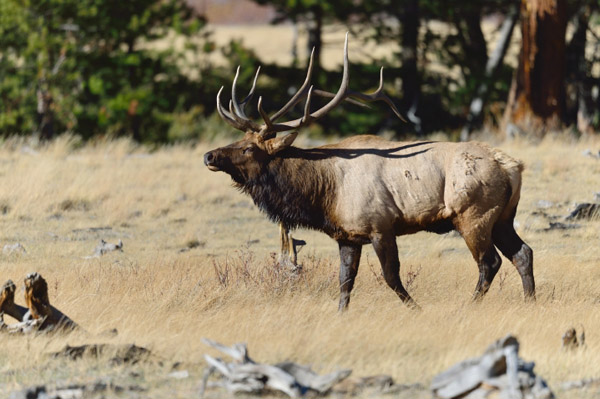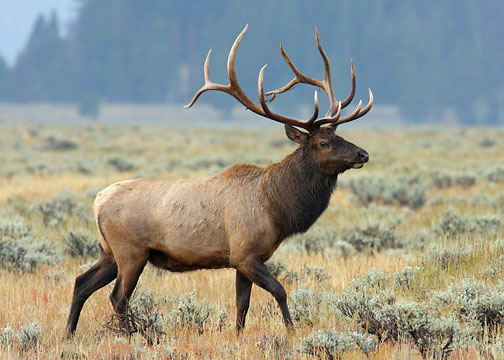Summer Scouting Tips for Elk
By Brad Vargo
MonsterMuleys.com Freelance Writer
So you are the lucky one with an elk permit in your pocket, but now the work begins. It is summer, elk season is only a few months away, and it is time to get out and scout your unit. I like to break down elk scouting into two equally important actions: pre-scouting actions and scouting actions. Pre-scouting actions are those actions that can be done at home and should always be done before you put boots on the ground. There are seven of them with the first being to break down the unit into smaller hunt able sections. This is where you take your maps (topo, aerial, etc.) and start making some phone calls. Call the local area biologist first and ask him/her to rate drainages in your unit as low, medium, or high for elk density and mark the info on your map. This will help to prioritize places to scout. Also, ask them the current bull to cow ratio. You want a minimum of 20/100 for a trophy hunt. The greater the ratio, the better your chance at mature bull. Finally, ask them the average age of harvested bulls and what size of bulls to expect. This will give you an idea to the caliber of bull you can expect to harvest. Also call the local game warden, local conservation officer, BLM range officer, and any of your fellow hunters that have hunted the unit.
After you have several good areas identified, it's time for the second pre-scouting action, look at the access of those areas. You can rate access as easy, medium, or hard. Mark the access rating on your map for later reference. Easily accessible areas should probably be avoided if you are looking for a top-end bull for your area. Focus your efforts on the medium and hard areas and try to find any alternative ways of access, like access by river or lake. Putting forth the extra effort to get to hard to reach areas can pay big dividends. The third pre-scouting action is to identify what type of terrain you are going to be hunting and adjust your scouting/hunting strategy to accommodate it. Elk country ranges from the desert to high mountain basins and everything in between. Ask a few of the locals what type of terrain and vegetation can you expect on the unit. Is the majority cedars, or sagebrush, or pine? The more information you have before you set foot on your unit the better, as this will help you paint a mental picture of your area. Remember, big trophy bulls will prefer a certain terrain and or vegetation in your unit. Your job is to find out what that is.
The fourth step, elk movement patterns, will help you determine where and when to look for elk. Is this hunt a migratory hunt? When do the elk head down onto inaccessible private lands? Do your elk hole up on transition zones? What do the elk do at the first sign of pressure? Answer these questions and any others you can think of. The fifth action is to identify if your unit will have any livestock issues with your hunt. For example, domestic sheep and elk do not mix. Many a hunt has been ruined because a hunter scouts out an awesome area with fresh sign and big bulls only to have a sheep herder move a flock into your drainage a couple weeks before the opener. As soon as the sheep show up, the elk leave immediately. Sheep herders typically graze the same areas each year so check with the locals. The sixth pre-scouting action is to identify several suitable camping sites so you can check them out during your scouting trips. Do not put this off until the last minute as you will need backup areas to camp in case of overcrowding or if you need a certain amount of camping space for trailers, ATVs, or horses. The last action, finding out any weather concerns, is where you make sure you are prepared for both your scouting and hunting trips. Does heavy rain wash out the roads or turn them into impassable mud? Do you need a set of snow chains? On an alpine hunt, is the area prone to lightning strikes or forest fires? Does your unit have extreme heat in the summer? Answering these questions will allow you to be fully prepared for whenever you set foot on your elk unit. Now that your pre-scouting actions are complete, you are now ready to hit the ground running.
When scouting for elk I like to remember some key things to keep in mind. First, and most important, is to get familiar with your unit. Check out and drive all the roads in the unit so you know how to get around. Check out and walk the trails in all the areas you have identified. The key in this step is to compare how it looks in person vs how it looks on the map. Many a time I have diligently scouted out areas at home only to find them unnavigable in person. This step will help you narrow down your search for prospective areas. Just make sure to make notes on your map. Second, remember this is not deer hunting. Elk are primarily grazers not browsers and they eat a lot more on a daily basis than a deer eats, so finding food sources is key. Elk are herd animals that tend to live in scattered pockets throughout the unit and are not evenly distributed like deer tend to be. Third, know where to look for elk depending on the season and or weather. When it is hot in summer and early fall, elk will be on north to northeast slopes around wet meadows near thick vegetation and spring seeps. Look for wallows in these areas. In the cold of late fall, elk will be in the warmth of south and southwest slopes where the sun has melted off the snow exposing grasses.
Fourth, get up high and glass on different vantage points and make sure to glass the area both early and late. Look for areas that might hold elk like basins, benches, pockets of heavy timber, meadows, alder draws, north slopes and anything that will attract and hold elk. Make sure to mark all the information on your maps. This is the very important verification phase that corroborates all the map research you did in your pre-scouting phase. Fifth, do not be shy, talk to everyone you meet in the unit. You probably will not get the location of a big bull from a stranger, but you will get valuable secondary information you can use. This step can really be productive in extremely hard to draw areas as people have a greater tendency to freely give out information for an area they might never draw. Lastly, look for both fresh and old sign and mark it on your map. You are looking for old rubs, wallows, game trails, and fresh bedding areas. As you gather this information, patterns can develop that may help you understand local elk movements. Remember, during the spring and summer months when elk are feeding on green grass, their droppings will look like small cow pies and then change to pellets in the fall. Putting in the time to effectively scout for elk will pay huge dividends in the field and hopefully will result in you tagging the bull of a lifetime.



